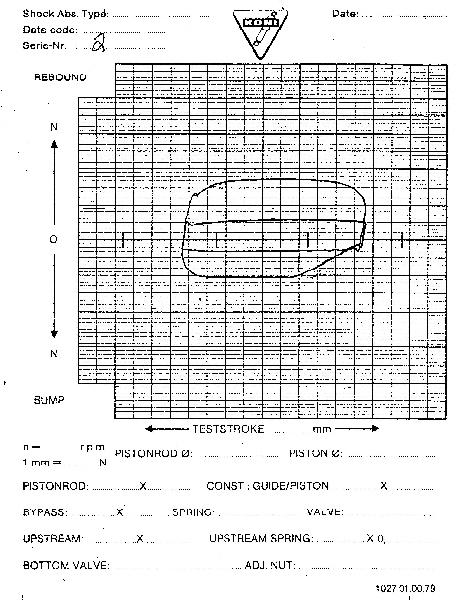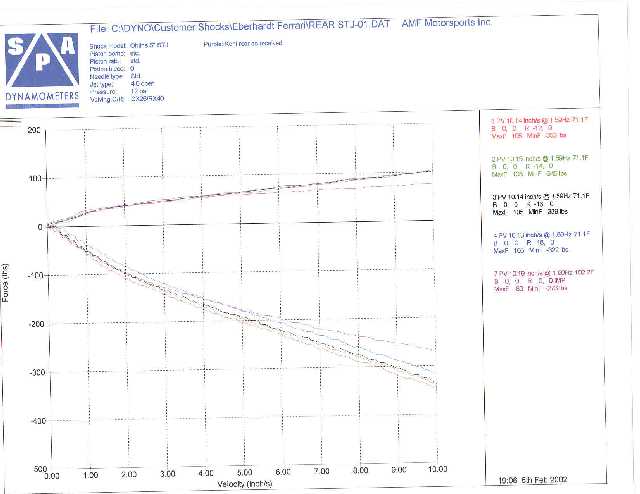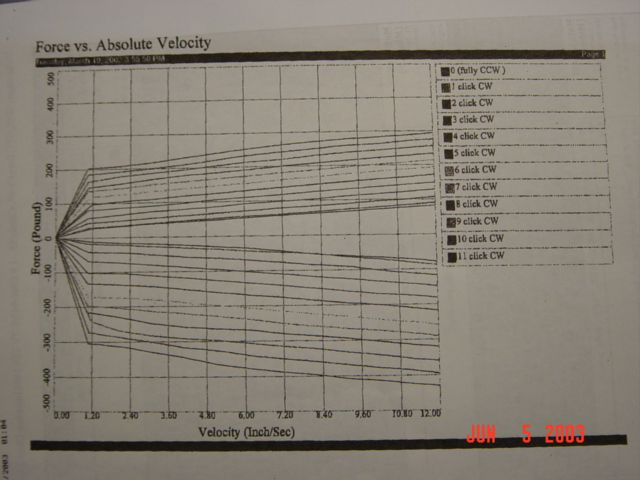| Author | Message | ||
| Rob Schermerhorn (Rexrcr)
Member Username: Rexrcr Post Number: 654 Registered: 11-2002 |
Bill, that truncated portion of the force vs. position graph in the lower right, shows a lag or cavitation of the damper. We call this type of response plot the "football", and it's good for highlighting cavitation problems. Good information, thank you for sharing. | ||
| Bill Sebestyen (Bill308)
Member Username: Bill308 Post Number: 469 Registered: 5-2001 |
These are the shock dynomometer curves for the Koni 8211's on the rear of my GTS.   While hard to see, the min and max adjustment curves are shown. My initial adjustment follows a curve between the extremes, but closer to the min damping curve. This should be very close to stock damping. | ||
| Alan Ing (Alan)
New member Username: Alan Post Number: 7 Registered: 2-2002 |
Henry, If your shocks came from Italian Design & Racing, they are Aldan Eagle Shocks who primarily sells to the Hot Rod industry. I've spoken to them before. Perhaps you can call them directly for those graphs. Also, that shock set up that you see from time to time on ebay with the antisway bars is based on the QA1 Halshock. Regards, Alan Ing | ||
| Mark Eberhardt (Me_k)
Member Username: Me_k Post Number: 533 Registered: 5-2002 |
Rob, you have mail. | ||
| Rob Schermerhorn (Rexrcr)
Member Username: Rexrcr Post Number: 653 Registered: 11-2002 |
Mark, could you send me the original of your dyno sheet? I cannot make out the subtleties. Koni's in general don't have much for range of force responce adjustment. Bilstein's do, as you can see. One other note, this Bilstein Porsche set-up was from Europe where the surfaces are less choppy than here in the US. We couldn't run that much high-speed bump force. | ||
| Mark Eberhardt (Me_k)
Member Username: Me_k Post Number: 532 Registered: 5-2002 |
Again wow. My adjusters don't make anywhere near as big a difference and that is one heck of a stiff shock. The purple is a stock Koni  | ||
| Rob Schermerhorn (Rexrcr)
Member Username: Rexrcr Post Number: 652 Registered: 11-2002 |
Henry, I've seen your graph before, but I can't remember the manufacturer now. That's arguably not real data. See if you can find out the manufacturer. Here's a sample of real data. This is a Bilstein strut from a Porsche GT3 ALMS car.  This graph shows the full soft and full stiff adjustments. I couldn't find my data showing each click. Adjusters usually don't act so linearly like in the photo you posted. Normally, the force curves diverge as velocity increases, even with digressive valving. The data you show is almost unbelievable, such nicely grouped and behaved responce to adjustments. | ||
| Mark Eberhardt (Me_k)
Member Username: Me_k Post Number: 531 Registered: 5-2002 |
Wow, the grahps for my olihs shocks look nothing like that! I think the only place they match is at zero. I'll see if I can get them scanned to post, but compression, is 0-100 and almost a prefect straight line, rebound is 0- (-250 to -350) depending on adjuster setting, there is a very gentle arch to the line, but again nearly straight. I'm really happy with them with 450/400 spring used mostly on the street with an autocross here and there. | ||
| Henry D. Chin (Hanknum)
Junior Member Username: Hanknum Post Number: 162 Registered: 2-2002 |
Rob- Here's the info. What do you think? Again, I was considering 275-300# fronts and 250# rear springs.  | ||
| Rob Schermerhorn (Rexrcr)
Member Username: Rexrcr Post Number: 644 Registered: 11-2002 |
This will speak volumes for the manufacturer. Many will balk at supplying this information, or will point to photos in their catalog. I've spoken with shock manufacturer's sales reps who could not explain specifically how their shocks adjuster worked, just "It changes the rebound setting." But how? "I don't know." | ||
| Rob Schermerhorn (Rexrcr)
Member Username: Rexrcr Post Number: 643 Registered: 11-2002 |
You will change the balance by changing wheel frequencies front to rear. If you're happy with the balance, drive on the street more than track, but want a "tighter" feel, just rebuild the shocks with heavier weight oil. My recommendations are based on the fact that every modern Ferrari I've driven tends to understeer, in general (I know, the tail comes out too, it's a complex, not simple problem). The car responds well to increasing roll resistance bias toward the front, in general. This is analogous to tuning engines. You can buy someone's chip and plug it in, but it won't be the ultimate tune for your car. If you want the ultimate for you, you'll need a larger budget, and hands-on tuning from the chip burner, to optimize your car. | ||
| Henry D. Chin (Hanknum)
Junior Member Username: Hanknum Post Number: 158 Registered: 2-2002 |
Rob- I'll see if I can get the damper force vs. velocity data for you. The shocks have 12 adjustment settings where the resistance on both the bump and rebound sides of the piston are increased. | ||
| JPM (John_308qv)
Junior Member Username: John_308qv Post Number: 133 Registered: 4-2001 |
Thanks for the responses. This explanation of stiffer front vrs rear makes some sense. I was afraid of upsetting the balance of the car (which feels good to me now) by going with stiffer springs in the front. From what Ron is saying, adjusting the shocks is as important as spring rates (among other things) for balancing the car. I am going to lower front and rear the same to try and keep the same C.G. relationship front to rear as stock. John | ||
| Rob Schermerhorn (Rexrcr)
Member Username: Rexrcr Post Number: 640 Registered: 11-2002 |
Henry, what are their damper force vs. velocity data for front and rear? Are they adjustable? If so, get the data including range of adjustment. This is not just a matter of choosing different springs, it's suspension system. Each modification affects another characteristic. | ||
| Henry D. Chin (Hanknum)
Junior Member Username: Hanknum Post Number: 157 Registered: 2-2002 |
Rob- What types of spring rates would you recommend for a '78 GTS with 12" springs in front and 14" rears? This would be for the adjustable coilovers that ID&R sells. This would be a street car that would be tracked/autocrossed occasionally. I was thinking 275/250 (f/r). | ||
| Rob Schermerhorn (Rexrcr)
Member Username: Rexrcr Post Number: 639 Registered: 11-2002 |
This spring rate (300 lbf/in) yeilds 100 lbf/in at the wheel on a 3x8, very soft, relative to some other road cars, and common on most. "Stiff" as felt in driving down the road, is a quite subjective quality, and is many times caused by damping rates as much or more than spring rates. | ||
| Mitch Alsup (Mitch_alsup)
Member Username: Mitch_alsup Post Number: 718 Registered: 4-2002 |
Lets say you are comparing springs with equivalent ride heights (before and after): As you increase the spring rates, the (original) anti-roll bars do (proportionatly) less work. So you make up for not increaseing the ARBs by using slightly different spring rates than you would if you changed both springs and ARBs. With this in mind, both the 225/250 (firm) and the 300/350 (hard) would not be hard to tune with tire pressures. If, on the other hand, the new springs change the ride height, or the rake of the car, then this moves the roll centers around. With different roll centers, the roll couple distribution will have changed, necessitating different spring rates and/or different ARBs. These cars, with minimal polar inertia, can be and are extremely sensitive to setup. Get it right, and you look like a genious; get it wrong, and miatas fly by you in corners. | ||
| Rob Schermerhorn (Rexrcr)
Member Username: Rexrcr Post Number: 635 Registered: 11-2002 |
Roll couple distribution biased to the front makes modern Ferraris, in general, handle better on the track. Suspension tuning is always a compromise. | ||
| JPM (John_308qv)
Junior Member Username: John_308qv Post Number: 132 Registered: 4-2001 |
After seeing a Euro QV when I picked up my 308 after servicing, I just ordered up front euro bumper and grill from Butch Hooper. With the lighter weight on the front, it�s time to look at adjustable shocks and springs. I searched the archives on recommended spring rates and am looking for expertise and advice from the forums users once again. The stock spring rates are 175/186 front/rear (slightly stiffer in back). The archive showed people recommending 250/200; 250/225; 300/350 and others. All of these rations have stiffer springs in front. Anyone know the reason to go with stiffer front springs? My limited understanding of this indicates that stiffer front springs would tend to cause the car to under-steer more than the stock factory spring rates with slightly stiffer rear springs. Any comments or suggestions/recommendations on spring rates will be greatly appreciated. Thanks, John |